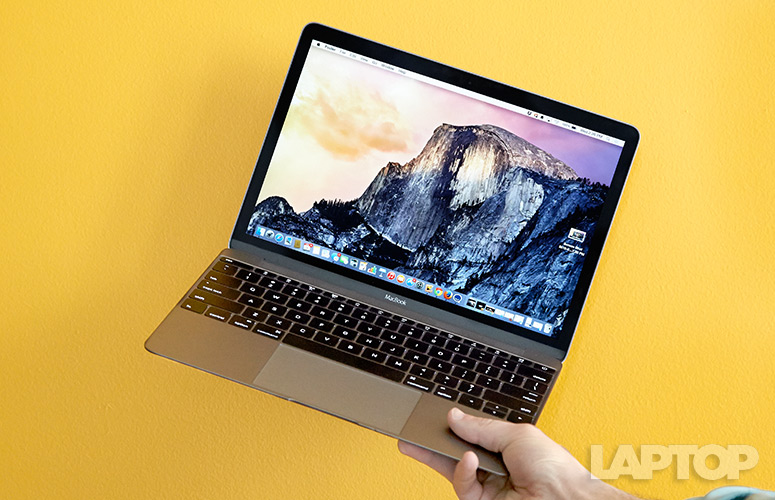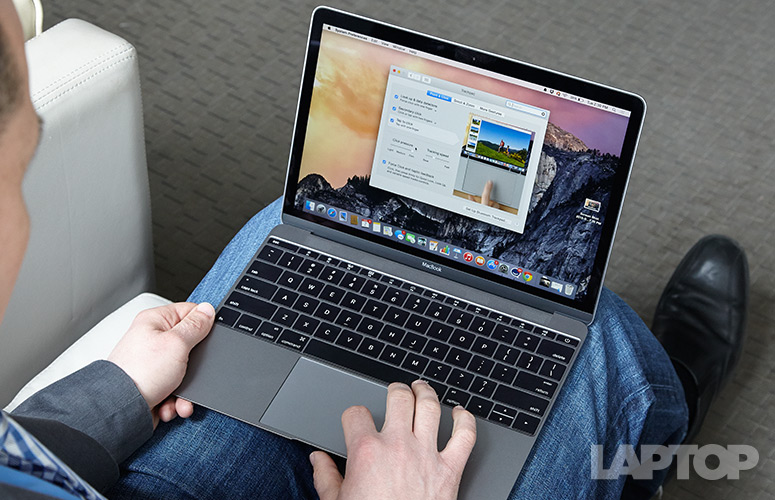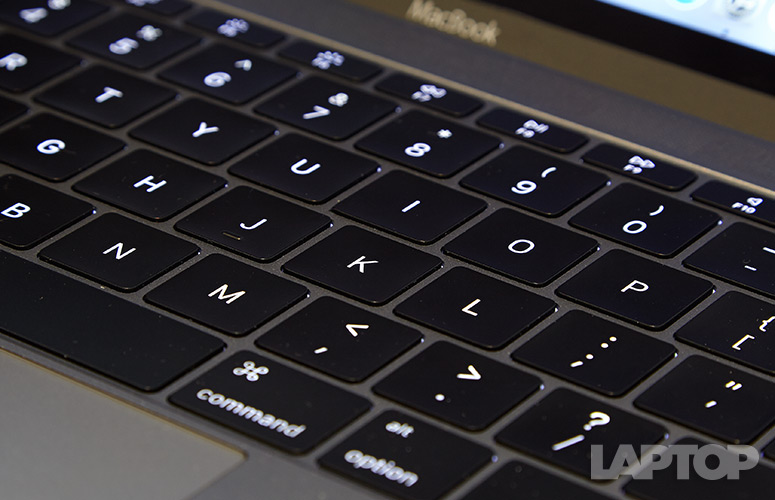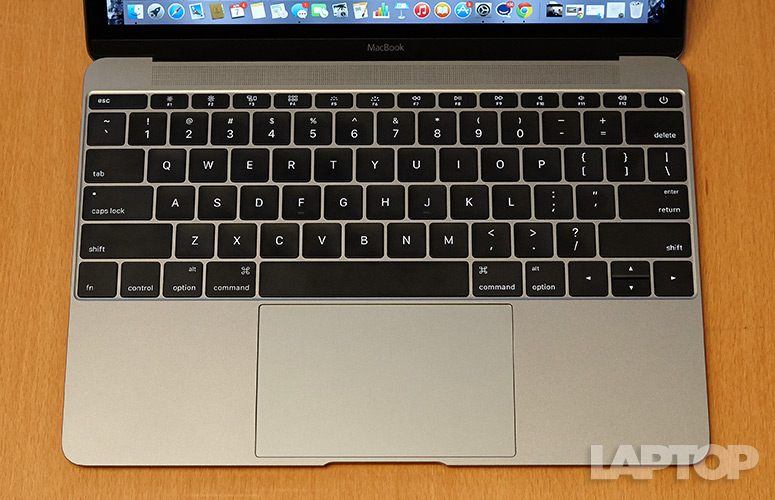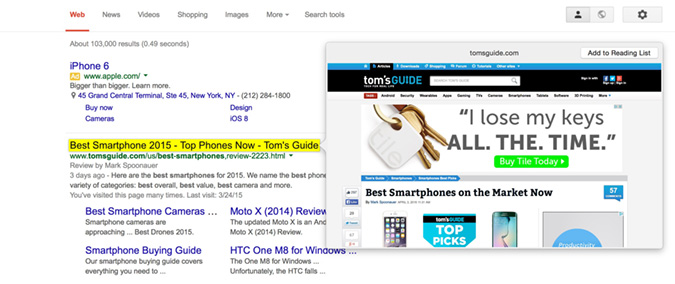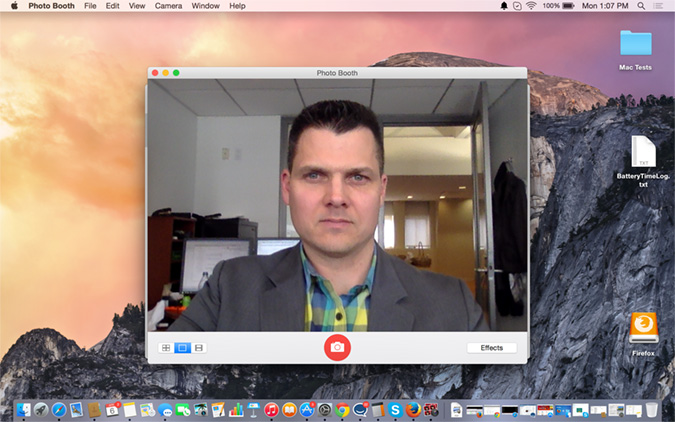Laptop Mag Verdict
The new MacBook is a fantastically light and compact laptop that delivers a rich display, long battery life and surprisingly strong ergonomics, but it needs more ports.
Pros
- +
Wonderfully light yet sturdy aluminum design
- +
Three color options
- +
Keyboard remarkably fast
- +
Awesome stereo speakers
- +
Strong battery life
Cons
- -
Must use dongle to plug in most devices
- -
Pricey
Why you can trust Laptop Mag
Remember when folks flipped out over the first iPad's lack of a USB port? Like that game-changing tablet, Apple's new MacBook is defined just as much by what it leaves behind as what it packs in. To create one of the thinnest and lightest laptops ever, Apple shoved all the usual ports and slots to the curb in favor of a single USB-C port for both power and data. Yes, just one. Apple also employed a radically new keyboard and touchpad design to squeeze as much functionality as possible into a shockingly portable 2-pound chassis. Just get ready for some sticker shock, as this system costs $1,299.
I replaced my 13-inch Air with the new MacBook for over a week and found it to be a mostly satisfying replacement, but only some shoppers will want to pay the price (literal and figurative) to own one.
Who's It For: Apple fans who crave the thinnest and lightest laptop possible and who are willing to live without multiple ports.
[sc:video id="w1MjFndDoeI83HuhciUPDHW2fieK-pwk" width="675" height="462"]
Lighter Than Air
"Man, is this thing light," I thought to myself as I picked up the new MacBook. This is the lightest Mac ever, thanks to all the miniaturization work Apple did on the inside. For instance, the main logic board is 67 percent smaller than the 11-inch MacBook Air's. And yet the MacBook feels supersturdy, thanks to the all-anodized-aluminum body.
I'm happy to report that, after so many years of aesthetic sameness, Apple has finally added color options to the MacBook line. I took the space-gray model for a spin, which looks more sophisticated than the standard silver, but you can also pick one up in gold. (It's blingy without being too in-your-face.) All three models have elegantly rounded corners and a lid that's easy to open, albeit without a logo that lights up.
Sign up to receive The Snapshot, a free special dispatch from Laptop Mag, in your inbox.
When the MacBook is opened, the backlit keyboard stretches from edge to edge (no wasted space here), but there's a fairly chunky display bezel compared to the Dell XPS 13's virtually borderless display.
Weighing 2 pounds and measuring 11 x 7.7 x 0.14 to 0.52 inches, the MacBook is a full pound lighter than the 13-inch MacBook Air and even more compact than the 11-inch Air (2.38 pounds, 11.8 x 7.6 x 0.68 inches). At 2.6 pounds, the XPS 13 is heavier, but it fits a larger 13-inch display into a design that's not that much bigger (11.98 x 7.88 x 0.33-0.6 inches) than the new MacBook.
Some people may think the MacBook is just too damn small. After all, a 12-inch display isn't for everyone. Plus, this system's low profile means the screen sits fairly low when you're working with it on your lap. But I'm glad that I can smirk instead of cringe when the jerk in front of me reclines his airline seat all the way back.
The USB-C Gamble
If you're a fan of extreme minimalism, you'll love the edges of the MacBook. The right side houses two microphones and a headphone jack, and the left side is home to a single USB-C port. You won't find a standard USB 3.0 port, SD card slot or any other port. The MagSafe connection for power -- which helped prevent you from accidentally crashing your notebook on the floor when tugging on the cable -- is also gone.
For those unfamiliar with USB-C, the new standard enables charging, USB connectivity and video output through a single connection. That's pretty versatile, but you're limited in what you can do, unless you shell out for accessories.
For instance, to charge your iPhone using the MacBook or to plug in a camera, you'll need to purchase a $19 USB-C-to-USB adapter. This adapter occupies the laptop's lone port, so you won't be able to juice the laptop with that dongle plugged in. A separate $79 USB-C Digital AV Multiport Adapter lets you connect an external display, USB device and the MacBook's USB-C power cable simultaneously. When I'm already paying $1,299, I shouldn't have to spend an extra $79 to charge my laptop and plug in another gadget at the same time.
I'm sure there are plenty of folks who won't care about the lack of ports. Plus, Apple's clout is already starting to spur a cottage industry of USB-C accessories. For example, Belkin has introduced nine USB-C cables ranging from $20 to $30, and Samsung has introduced a USB Type-C drive. Regardless, I wish that Apple had at least added a single USB 3.0 port or a second USB-C port.
The Perfect Display
This is the screen I wish my MacBook Air had. The 12-inch Retina display on the MacBook packs 2304 x 1440 pixels into an IPS panel with ultrawide viewing angles. And it's one rich picture, as evidenced by the Furious 7 trailer I watched in Ultra HD on YouTube. I could make out every wrinkle in Vin Diesel's determined forehead during a close-up, as well as the trail of glass his car left as it exploded out of a high-rise whose facade was a rainbow of reflected colors.
On our lab tests, the MacBook's screen produced results as beautiful as the picture. The panel reproduced 101.8 percent of the sRGB color gamut (higher is better), compared with 97 percent for the touch version of the Dell XPS 13 and 93.9 percent for the Asus ZenBook UX305. The 13-inch Air registered only 63 percent. The colors on the new MacBook are very accurate, too; it scored 1.2 on the Delta E test (lower is better).
The MacBook's display averaged 353 nits of brightness, which blows away the category average (261 nits) and beats the Dell XPS 13 with touch (295 nits), the Asus UX305 (281 nits) and the Air (288). That brightness also helped me easily see content on the screen in direct sunlight, even though the glossy panel has a glossy finish.
Flat But Quick Keyboard
What's most surprising about the new MacBook is that I typed even faster on its all-new keyboard than on the MacBook Air. This was possible even with its very shallow travel of just 0.5 mm, which is lower than even the Surface Pro.
What makes the keyboard so different is a new butterfly mechanism that replaces the traditional scissor switch. Apple also enlarged the key surface area by 17 percent while providing a deeper curvature to each key.
On the 10FastFingers.com test, I averaged 70 words per minute, compared with 65.7 wpm on the 13-inch MacBook Air. However, I did make more errors on the MacBook (6, on average, compared with 3.6 on the MacBook Air), and I preferred the pillowy feel of the Air's keys. The MacBook's keys felt stiffer.
The Force Is with This Touchpad
Like the new 13-inch MacBook Pro, the MacBook sports a Force Touch trackpad that uses haptic feedback to make it feel like you're clicking even though the pad doesn't actually depress. You can also adjust the sensitivity of the click pressure via the System Preferences menu; I preferred the Firm settings, as opposed to Light or Medium. Overall, the larger 4.4 x 2.8-inch touchpad proved accurate and responsive, whether I was scrolling in Safari or highlighting text.
With the Force Click feature, you can perform various time-saving functions. Deep-press on a word in Safari, for example, and you can look up a definition.
Do the same thing on a Web link, and you'll be able to preview the page without opening another tab. Clicking on an address in Mail or another Apple app lets you preview it in a Maps window.
Shockingly Good Sound
Despite its small speaker bar, the MacBook provides amazingly awesome sound. Even at maximum volume, the punchy vocals on Maroon 5's "Sugar" came through well, and the song had a robust bottom end. The opening horns on Ariana Grande's "Problem" easily filled my small office, and the singer's voice sounded silky smooth.
So-So Webcam
It's a bummer that Apple couldn't fit an HD camera into the new MacBook. Instead, it packs a 480p FaceTime camera with 848 x 480 pixels of resolution.
When I used Photo Booth, the camera faithfully captured my multicolored checkered shirt, but the image looked somewhat blurry when I zoomed in. In low light, the images looked even fuzzier.
Good-Enough Performance
While many ultraportable laptops in this price range (and lower) offer Core i5 processors, Apple opted for a more efficient 1.1-GHz Core M CPU in order to deliver a silent fanless design. The starting configuration also comes with 8GB of RAM and 256GB of PCIe flash memory.
In everyday use, the MacBook easily handled more than 10 applications open while I surfed the Web in Chrome with several tabs running. In addition, this notebook resized large images instantly in the Pixelmator app.
On Geekbench 3, which measures overall performance, the new MacBook scored 4,631, which is slightly higher than the Core M-powered Asus UX305 (4,623). However, the Core i5-equipped Dell XPS 13 notched about 1,000 points higher on the same test (5,653), and the 2014 MacBook Air with a similar CPU hit 5,393. In case you're wondering, the identically priced 13-inch MacBook Pro (with Core i5) lapped the field with 7,113.
When we ran our spreadsheet macro test, which matches 20,000 names and addresses, the MacBook took 4 minutes and 33 seconds. That's actually speedier than the XPS 13, which took about 5 minutes but wasn't quite as quick as the older Air (which took less than 4 minutes).
The flash memory definitely gives this laptop some pep. On our file-transfer test, the MacBook delivered a rate of 254.5 MBps, compared with 154.2 MBps for the XPS 13 and 154.2 MBps for the Asus.
You can edit video on the new MacBook, but it's not very fast. In iMovie I imported the same 35MB 720p HD clip to both the MacBook and 13-inch MacBook Air, and then used it to create a new movie using the Modern template. I auto enhanced the foootage and then exported the clip in Medium quality. The MacBook took 1 minute and 36 seconds, but the Air took just 52 seconds.
Don't expect to play mainstream games using the Intel HD Graphics 5300 on this laptop. Even at a low resolution of 1280 x 800 pixels, the MacBook mustered only 27 frames per second on World of Warcraft. That's below our 30-fps playability threshold.
Above-Average Battery Life
Apple developed new terraced, contoured batteries to fill every nook and cranny of the new MacBook that isn't taken up by other components. The thin display also helps, as Apple claims that it's 30 percent more energy-efficient than any other MacBook. As a result, the MacBook offers fairly impressive endurance, lasting 8 hours and 43 minutes on the Laptop Mag Battery Test (continuous Web surfing over Wi-Fi at 100 nits of screen brightness).
MORE: Laptops with the Longest Battery Life
The MacBook's runtime is about an hour longer than the category average and is also well ahead the quad-HD touch screen version of the Dell XPS 13 (7:24). However, the nontouch version of the XPS 13, which has a less-power-hungry 1080p display, lasted 11:42, and the 13-inch Air delivered more than 12 hours. The Asus UX305 (also 1080p) outlasted the MacBook, at 9:38.
Cool Customer
Not only is the MacBook whisper quiet, thanks to its fanless design, but it also runs cool. After streaming a Hulu video for 15 minutes, the touchpad registered 81 degrees Fahrenheit, and the keyboard hit 87 degrees. Only the bottom of the system approached -- but didn't surpass -- our comfort threshold of 95 degrees.
Seamless Software
The MacBook runs OS X Yosemite, which seamlessly integrates with the iPhone. For instance, with the Continuity feature, you can send and receive texts right from the desktop with the Messages app. Or, you can make or take calls from your iPhone. Another handy feature is AirDrop, which makes it a cinch to share files from your iPhone to the Mac or vice versa.
With iCloud Drive, Apple offers a viable alternative to Dropbox for those who don't venture outside the Apple ecosystem. Other highlights include the complete iWork (Pages, Keynote, Numbers) and iLife (iPhoto, iMovie, GarageBand) suites for working on documents, editing photos and videos, and more.
Configuration Options
The starting $1,299 configuration of the MacBook packs a 1.1-GHz Core M processor, 8GB of RAM and 256GB of flash storage. Stepping up to the $1,599 model bumps the CPU up to a 1.2-GHz Core M and the storage up to 512GB. All configurations of the MacBook come with 802.11ac Wi-Fi and Bluetooth 4.0.
Bottom Line
My initial reaction to the MacBook was that it was too ahead of its time, but there are lots of things I love about it right now. The new butterfly keyboard and touchpad design make this 2-pound wonder surprisingly comfortable to use for long stretches, and the ultrabright and colorful Retina display make the experience all the more pleasant. Apple's engineers also deserve a shout-out for the loud and clear speakers that put laptops twice as big to shame.
On the other hand, $1,299 is a lot to ask for a notebook that offers comparable performance to systems that cost hundreds less (like the $699 Asus UX305), and the new MacBook lasts about 3 hours less on a charge than Apple's own 13-inch Air. Then again, I don't want to go back to my Air's bland, low-res display now.
Then, there's the single USB-C port. About 90 to 95 percent of the time, I don't need extra ports, but when I do, I don't want to carry around extra dongles. My dream machine would have everything the new MacBook has but in a slightly larger size with one more port. But if you're ready for an all-wireless future, the MacBook's sheer portability and utility per square inch make it worth the splurge.
Apple MacBook 12-inch (2015) Specs
| Bluetooth | Bluetooth 4.0 |
| Brand | Apple |
| CPU | 1.1GHz dual-core Intel Core M processor |
| Company Website | www.apple.com |
| Display Size | 12 |
| Graphics Card | Intel HD Graphics 5300 |
| Hard Drive Size | 256GB |
| Hard Drive Type | Flash |
| Native Resolution | 2304 x 1440 |
| Operating System | OS X Yosemite |
| Ports (excluding USB) | USB-C, Headphone |
| RAM | 8GB |
| RAM Upgradable to | 8GB |
| Size | 11 x 7.7 x 0.52-0.14 |
| Touchpad Size | 4.4 x 2.75 |
| USB Ports | 1 |
| Weight | 2.03 pounds |
| Wi-Fi | 802.11ac |

